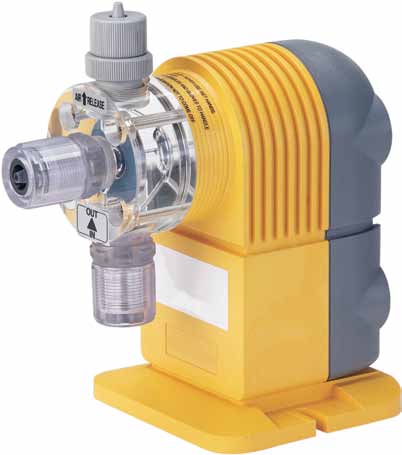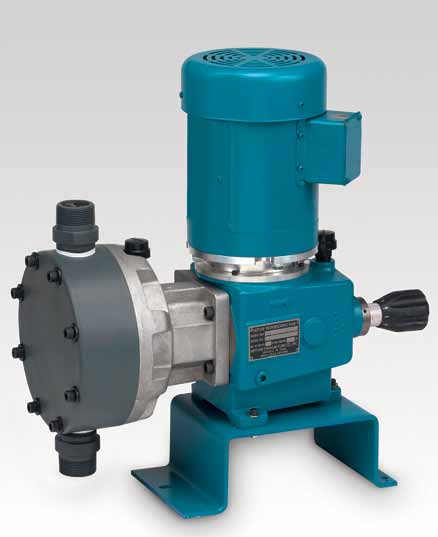Mechanically actuated metering pumps improve operational efficiencies and eliminate concerns associated with off-gassing in sodium hypochlorite applications.
To most people, sodium hypochlorite is simply known as liquid bleach. To the people charged with producing, transporting and metering sodium hypochlorite in a wide range of industrial applications, there is nothing simple about it. Sodium hypochlorite was first produced in 1789 when Frenchman Claude Berthollet passed chlorine gas through a solution of sodium carbonate. Today, sodium hypochlorite is formed when chlorine gas is bubbled into a cold and diluted sodium hydroxide solution.

An electronic metering pump
Finished sodium hypochlorite is a clear, slightly yellowish solution with a characteristic odor. In its commonly used liquid-bleach form, it has 5 percent sodium hypochlorite with a pH of around 11, which makes it irritating to the skin.
However, in more concentrated doses, such as 10 to 15 percent sodium hypochlorite, its pH level rises to 13, which means it will burn and be corrosive to many substances. That is why anyone working with high levels of sodium hypochlorite must take precautions to protect themselves and the environment.
These precautions are being taken daily at industrial facilities around the globe because sodium hypochlorite is a key component in thousands of production or disinfection processes in industries as diverse as agriculture, chemical, paint, lime, food, glass, paper, pharmaceutical, synthetics and water treatment.
The powerful disinfection and oxidation properties of sodium hypochlorite allow it to be used in such operations as bleaching in the paper and textile industries, disinfection of drinking water, preventing the growth of algae and shellfish in industrial or HVAC cooling towers and disinfection and odor control in wastewater facilities.

Mechanical diaphragm metering pump
The Challenge
This article focuses on the use of sodium hypochlorite as a disinfectant and odor controller in wastewater treatment plants. In wastewater treatment applications, sodium hypochlorite is introduced to the system via metering pumps. In addition to the need to handle sodium hypochlorite with care because of its elevated pH levels, a critical concern when pumping and metering the liquid is its propensity to “off gas.” When this happens, the consequences to metering pump operation include air binding and loss of prime, which adversely affect the operational efficiency of the metering pump, leading to compromised metering operations.
To combat off-gassing in metering pumps during sodium-hypochlorite-handling operations, facility managers can follow a number of simple steps to minimize concerns:
- When selecting a pump style for use in sodium hypochlorite metering, always use a high-stroking model with a short stroke length. This type of pump is less likely to allow the accumulation of gas in the pump head.
- In pumps that are turned off for a length of time, the gas can accumulate in the suction line or pump head. For applications that require the pump to sit idle for any period of time, including a bypass line with an automated valve that can recirculate the sodium hypochlorite when not feeding is recommended.
- Provide a short, flooded suction-pipe arrangement for the metering pump with the suction piping sloping down from the storage tank to the pump. This setup will allow any gas bubbles to travel back to the storage tank, rather than to the head of the metering pump. This also means that the metering pump that is used in sodium hypochlorite service should not be top-mounted, unless the concentration is very low.
- Ensure that the sodium hypochlorite's feed tank is not located in direct sunlight. Direct sunlight and higher temperatures will increase sodium hypochlorite off-gassing.
- Use a sodium hypochlorite solution with the lowest concentration possible for the application, and use the largest capacity metering pump possible. This combination will result in less off-gassing.
- If possible, use an air vent or purge valve in the head of the metering pump. This will aid in evacuating any trapped sodium hypochlorite gas that may reach the metering pump.
The Solution
The type of pump that can meet all requirements for handling sodium hypochlorite in wastewater applications—especially in combating the deleterious effects of off-gassing while providing accurate metering—are mechanically actuated diaphragm pumps (electronic or motor driven). The piston in a mechanically actuated diaphragm pump is attached to the diaphragm and is normally compressing a spring in the forward (positive) movement of the piston ensuring positive diaphragm return and, therefore, assisting suction.
More specifically, a mechanically actuated diaphragm pump that has a high stroking speed and short stroke length should be used to minimize gas accumulation in the pump head. In addition, the pump can be provided with an automatic vent valve to allow any trapped gas to be purged from the pump head. Some of these pumps are offered with manual control, automatic control or fully programmable control features.
Another feature is a straight through flow path pump head, which does not allow any areas within the pump head for the gas to lodge. Also, look for pumps that are self-priming. Two materials that are most suitable for sodium hypochlorite applications are PVC and Kynar.
Conclusion
Sodium hypochlorite is one of the most versatile cleaning and disinfecting fluids available. From completing basic household chores to disinfecting hospitals, from being fed as a biocide to inhibit biological growth to removing odors from wastewater, sodium hypochlorite plays an ever-present role in a wide array of day-to-day operations around the world.
However, it must be handled with care, especially in its higher concentrations. It also has a few quirky characteristics that, if not addressed, can hamstring an industrial application. Facility managers familiar with these characteristics know that they need to select, use and rely upon the best metering-pump technology when metering sodium hypochlorite. Finding the right pump technology is especially crucial when considering the negative affects that off-gassing can have on sodium hypochlorite metering operations.
That's why managers of wastewater treatment facilities who want to optimize production while simultaneously reducing maintenance costs, downtime and product loss choose mechanically actuated diaphragm metering pumps for their sodium hypochlorite-handling responsibilities.
Pumps & Systems, October 2011

